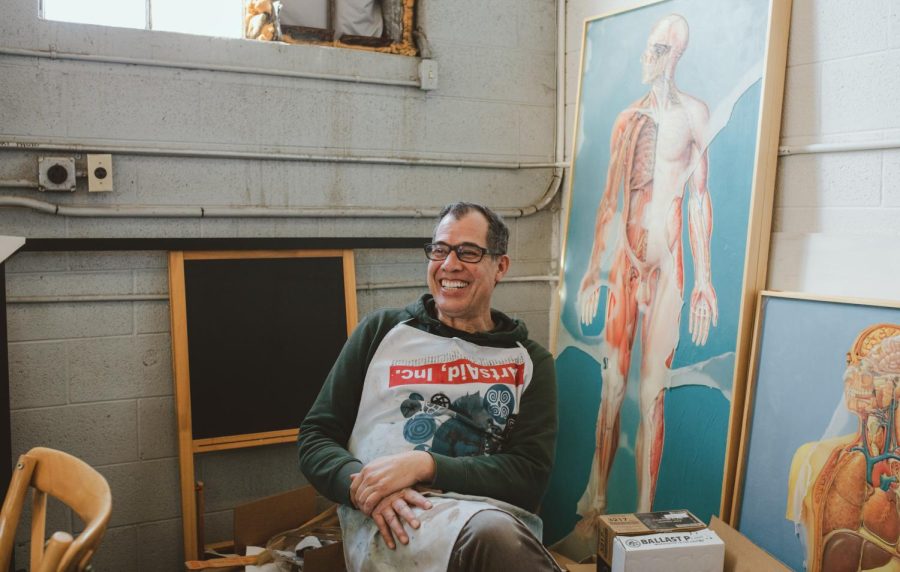Looking to the Future while Remembering the Past: an Interview with Artist Jorge Rojas
Jorge Rojas (Photo by Emily Rincon | The Daily Utah Chronicle)
April 5, 2022
Jorge Rojas is an alumnus of the University of Utah and an artist residing in Salt Lake City, whose prestigious career has led to his works being displayed in museums and galleries all across North America, most recently the Utah Museum of Fine Arts and the UMOCA. He is also an independent curator and continues to educate in arts.
As Rojas prepares to open his Mid Career Retrospective at Granary Arts later this year, I had the pleasure to speak with the artist on the nature of art in his life, the wisdom he has gained and how his work has shaped his life.
Best of Both Worlds
Rojas hails from Cuautla, Morelos, Mexico. While he moved to Utah at only 6 years old with his mother and siblings, he remembered it quite well, saying, “We came and were put right into the public school systems and we were expected to learn English right there.” Being raised in a predominantly white and conservative state had some effect on his artistic expression, but the development of his nuanced style was influenced by spending time with his father in Mexico while growing up in the United States, which helped Rojas hold onto his Mexican identity.
The arts were very prevalent in Rojas’ childhood, from music to dance to visual art — he jokes that his mother wanted the family to be the “Mexican Osmonds.” “Moving back and forth made me a chameleon of sorts, learning to navigate these two very different countries and cultures,” Rojas said. “I feel like that helped shape my identity and shape how I saw the world.”
Art for Everyone
From the beginning, Rojas wasn’t thinking of creating “Mexican Art.” “The most appealing art are pieces that deal with universal issues,” he said. “With time I came to realize that being a Mexican immigrant had deeply influenced my art. You think about the colors and the textures, the music, the customs and ritual, the sense of history and injustice — those are all deeply part of me and show up in my work in various ways. As I’ve grown up I’ve come to own that and become proud of that.”
Rojas is adamant that representation for all people must be exhibited in all things. “You want to see yourself on the walls of a museum,” he said. “It’s important to feel seen; differences matter.” Rojas spoke of the Mexican Muralists Movement, which promoted the idea of art “for the people by the people” as a means to inspire and help those struggling come to terms with their identity. Rojas states he does feel a responsibility to celebrate artists who have been underrepresented as well, such as BIPOC, immigrant and LGBTQ+ artists who need their voices heard.
Community as a Key Role in Social Change
I was intrigued by many of Rojas’ performance art pieces, in which he sometimes employs help from audience members to create moving works of art that speak to injustices in the U.S. as well as society as a whole. He spoke on how performance art is vital in bringing communities together and inciting action. As an artist he wants to contribute something to society and change the world.
Over the pandemic, Rojas created a performance work entitled “A Dance For The Departed” which included 36 multicultural dancers dancing mournful rituals and rites as a representation of how COVID-19 disproportionately affects minority and Indigenous groups.
I asked him about the role of arts in obtaining social justice, to which he said, “I can use art to point to abuses of power. I’ve done pieces on police brutality, racial profiling, immigration, separation of families and the way COVID has disproportionately affected people of color.”
The artist views his work in three distinct genres — 2D and 3D abstract and minimalist works, performance art and art for social change. “My performances are designed to hold space for participants, observers and myself in gestures of protest, solidarity, remembrance and in healing,” he said.
The Artist in Everyone
Rojas’ career has spanned over four decades, working as a teacher for some of that time and a student for all of it, at the U and Bellas Artes in San Miguel de Allende, Mexico. “Taking a class [at the U], ‘Dance and the Creative Process,’ was really powerful. … It opened my eyes to what art can be. Expressing oneself in space and time, rather than painting a picture,” he said. Diversity in the arts was the key to inspiration. He spoke of his time at Bellas Artes as well saying, “I had a painting teacher — in Mexico, who inspired the ideal in me that if you can make something beautiful and thought provoking — that is powerful and worth something.”
Again, Rojas expressed that art is for everyone and creativity exists in every aspect of being alive. All he needed was the encouragement of his teachers and professors to launch him into the career he is now. Discovering one’s sense of self is artistic and creative all on its own: “Through art you can help people find their sense of power and inspire civic duty.”
Looking to the Future
Rojas’ views on the arts are truly those of a person who’s dedicated their life to a craft. Through everything Rojas has worked on he has taken a lesson with it along the way. “Believe the process, keep making art, trust in oneself personally and spiritually,” he said. “To live life is a creative endeavor. Life is the ultimate art form.”
To celebrate his continuing career coming up spring of 2022 the summation of Rojas’ work so far will be displayed at Granary Arts in Ephraim, Utah from May 25 through Sept. 23.









